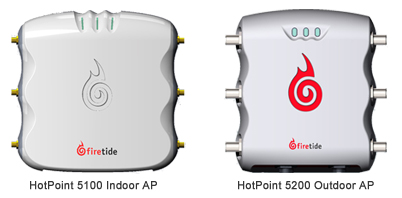 Models
Models
HotPoint 5100 – Indoor Tri-band Dual Radio Access Point
HotPoint 5200 – Outdoor Tri-band Dual Radio Access Point*
* Outdoor antennas not included. 3-in-1 detachable, high gain, spectrum-specific, omni directional and directional antennas available for purchase.
Download the Data Sheet
Firetide HotPoint wireless access points deliver a modular access solution for large scale, indoor and outdoor wireless mesh networks. Modular design enables full network and software integration of the access points with a Firetide wireless mesh network while at the same time permitting independent physical placement of the hardware to provide optimal accessibility for Wi-Fi clients.
Seamless Outdoor and Indoor Operation
Outdoor HotPoint 5200 access points have rugged NEMA 4X/IP67-rated cast aluminum enclosures and have one weatherproof connector for attaching to a Firetide wireless mesh node or a conventional Ethernet port. These units support high gain antennas and can receive power directly from a connected mesh node eliminating the need for an external power supply.
Indoor HotPoint 5100 access points provide wireless access within buildings and moving vehicles. Each indoor access point has a UL2043 plenum-rated enclosure and an RJ-45 connector for attaching to a Firetide wireless mesh node or a conventional Ethernet port.
Dual Radio Support
HotPoint 5000 series features two independently operating radios. Radio 1 is capable of operating in 802.11 b/g/n mode and Radio 2 is capable of operating in 802.11 a/n. In addition, the radio 2 also support client connectivity in the 4.9 Ghz based public safety band. The radios can operate in channel widths of 5,10, 20 and 40 MHz (MIMO only), with 5 and 10 MHz channel widths only available on the 4.9 GHz band. Alternatively, an Administrator could also decide to put one of the radios into a dedicated monitor mode which enables faster Rogue AP detection, mitigation, abuse prevention and faster adaption to RF environment changes.
Access On or Off the Mesh
HotPoint wireless access points can be mounted to a Firetide mesh node to provide Wi-Fi access to any indoor or outdoor location without the need for backhaul cabling. HotPoint access points can also connect directly to a conventional wired infrastructure eliminating the need to install a mesh node in locations where wired connectivity is readily available.
Modularity for Flexible Placement
Unlike conventional mesh networks that combine mesh backhaul and Wi-Fi access in the same enclosure, Firetide mesh nodes and access points can be physically separated allowing system integrators to optimize RF separately for both the mesh backhaul as well as client access.
For example, in a multi-building mesh network, mesh nodes should be placed in areas that enable the best connectivity between buildings which is typically at higher locations. However the best locations for the access points tend to be lower to provide the best connectivity for Wi-Fi clients inside a building. Because the access points and mesh nodes are kept in separate enclosures, they can be independently positioned for optimal RF connectivity.
Single-point Network Management for Mesh and Access
Whether connected directly to a Firetide wireless mesh network or to a wired infrastructure, the HotPoint access points are fully integrated and managed with the same HotView software used to manage Firetide mesh nodes. HotView provides remote management from a centralized location and users can manage all mesh and access traffic from a single console.
Advanced Security and Performance Features
HotPoint access points operate in the 2.4 GHz band and feature WPA2 and WEP encryption, up to 16 SSIDs, industry compliant QoS, and durable enclosures.
Designed for Hot Spots
Layered service levels can be enabled through Virtual APs (VAPs) and Virtual AP Groups. Each HotPoint AP supports up to 16 VAPs with support for a total of 128 clients, creating different logical networks with varying levels of security, access, and performance. Additional Hot Spot features include user-based rate limiting and intracell blocking.